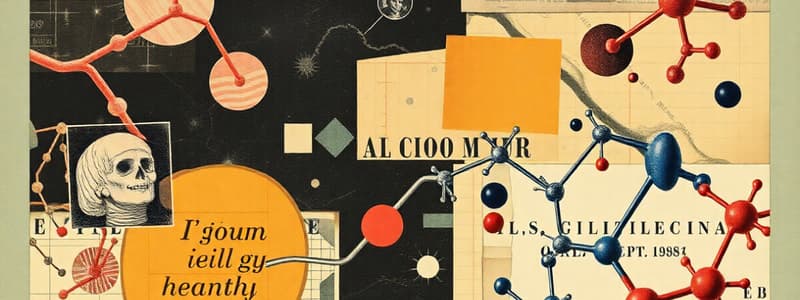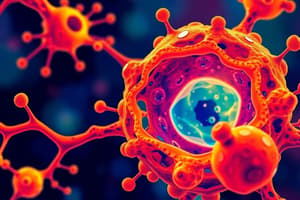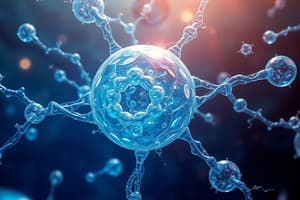Podcast
Questions and Answers
What is the purpose of adding a stain when preparing a temporary slide for a light microscope?
What is the purpose of adding a stain when preparing a temporary slide for a light microscope?
The stain enhances the visibility of cellular structures.
List the five key steps for drawing cells from a light microscope slide.
List the five key steps for drawing cells from a light microscope slide.
Observe, use pencil only, outline clearly, label accurately, and keep it simple.
What is the formula for calculating magnification in microscopy?
What is the formula for calculating magnification in microscopy?
Magnification = Image size / Actual size.
Why is it important to start examining a specimen under low magnification?
Why is it important to start examining a specimen under low magnification?
What should you do to avoid air bubbles when placing a coverslip over a slide?
What should you do to avoid air bubbles when placing a coverslip over a slide?
When labeling a drawing of a cell, what key structures must be included?
When labeling a drawing of a cell, what key structures must be included?
What is the recommended tool for drawing cells, and why?
What is the recommended tool for drawing cells, and why?
Why should a drawing of a cell be kept simple and proportionate?
Why should a drawing of a cell be kept simple and proportionate?
What effect do inhibitors have on enzyme activity?
What effect do inhibitors have on enzyme activity?
How does Vmax relate to the maximum rate of an enzyme's reaction?
How does Vmax relate to the maximum rate of an enzyme's reaction?
What does a low Km value indicate about an enzyme's affinity for its substrate?
What does a low Km value indicate about an enzyme's affinity for its substrate?
What distinguishes competitive inhibitors from non-competitive inhibitors?
What distinguishes competitive inhibitors from non-competitive inhibitors?
How can the Michaelis-Menten constant (Km) be used to assess enzyme performance?
How can the Michaelis-Menten constant (Km) be used to assess enzyme performance?
What are the advantages of using immobilized enzymes in alginate beads?
What are the advantages of using immobilized enzymes in alginate beads?
What is the outcome of adding more substrate in the presence of a competitive inhibitor?
What is the outcome of adding more substrate in the presence of a competitive inhibitor?
In what way does a non-competitive inhibitor affect enzyme activity, regardless of substrate concentration?
In what way does a non-competitive inhibitor affect enzyme activity, regardless of substrate concentration?
What is the primary function of the cell surface membrane in eukaryotic cells?
What is the primary function of the cell surface membrane in eukaryotic cells?
Describe the nucleus and its role in cell function.
Describe the nucleus and its role in cell function.
What is the structure and purpose of the Golgi apparatus?
What is the structure and purpose of the Golgi apparatus?
What is the shape and primary function of mitochondria?
What is the shape and primary function of mitochondria?
What structures make up centrioles and what is their function?
What structures make up centrioles and what is their function?
Explain the structure and function of chloroplasts in plant cells.
Explain the structure and function of chloroplasts in plant cells.
What is the composition and role of the cell wall in plant cells?
What is the composition and role of the cell wall in plant cells?
Describe the tonoplast and the function of the large permanent vacuole in plant cells.
Describe the tonoplast and the function of the large permanent vacuole in plant cells.
What role do enzymes play in biochemical reactions?
What role do enzymes play in biochemical reactions?
How do immobilized enzymes contribute to continuous processes?
How do immobilized enzymes contribute to continuous processes?
Describe the basic structure of a chromosome.
Describe the basic structure of a chromosome.
What is the significance of telomeres in chromosomes?
What is the significance of telomeres in chromosomes?
Why is mitosis essential for the growth of multicellular organisms?
Why is mitosis essential for the growth of multicellular organisms?
Explain how mitosis aids in the replacement of damaged cells.
Explain how mitosis aids in the replacement of damaged cells.
What happens during asexual reproduction in terms of mitosis?
What happens during asexual reproduction in terms of mitosis?
How do sister chromatids function during cell division?
How do sister chromatids function during cell division?
What is the formula for calculating actual size from image size and magnification?
What is the formula for calculating actual size from image size and magnification?
How do you convert millimeters to micrometers?
How do you convert millimeters to micrometers?
What are the two types of electron micrographs mentioned, and what does each visualize?
What are the two types of electron micrographs mentioned, and what does each visualize?
Why is it important to calibrate the eyepiece graticule?
Why is it important to calibrate the eyepiece graticule?
What is the purpose of using a stage micrometer?
What is the purpose of using a stage micrometer?
What unit should be used for measuring medium-sized objects like cells?
What unit should be used for measuring medium-sized objects like cells?
If you measure 5 divisions on the eyepiece graticule and each division equals 10 µm, what is the total length?
If you measure 5 divisions on the eyepiece graticule and each division equals 10 µm, what is the total length?
What is the relationship between nanometers and micrometers?
What is the relationship between nanometers and micrometers?
What is a tumor, and how does it form due to uncontrolled cell division?
What is a tumor, and how does it form due to uncontrolled cell division?
Describe the main characteristic that distinguishes benign tumors from malignant tumors.
Describe the main characteristic that distinguishes benign tumors from malignant tumors.
What happens to chromosomes during prophase of mitosis?
What happens to chromosomes during prophase of mitosis?
What is the significance of the spindle fibers during metaphase?
What is the significance of the spindle fibers during metaphase?
What occurs to sister chromatids during anaphase?
What occurs to sister chromatids during anaphase?
What are the main events that take place during telophase?
What are the main events that take place during telophase?
How can one identify the stage of a cell in a photomicrograph that is undergoing metaphase?
How can one identify the stage of a cell in a photomicrograph that is undergoing metaphase?
What is the final process that occurs after mitosis, and how does it differ in plant and animal cells?
What is the final process that occurs after mitosis, and how does it differ in plant and animal cells?
Flashcards
Actual Size
Actual Size
The actual size of an object in real life.
Image Size
Image Size
The magnified size of an object as seen through a microscope.
Magnification
Magnification
The ratio between the actual size of an object and its image size in a microscope.
Eyepiece Graticule
Eyepiece Graticule
Signup and view all the flashcards
Stage Micrometer
Stage Micrometer
Signup and view all the flashcards
Calibrating the Eyepiece Graticule
Calibrating the Eyepiece Graticule
Signup and view all the flashcards
Measuring with an Eyepiece Graticule
Measuring with an Eyepiece Graticule
Signup and view all the flashcards
Using the Right Units
Using the Right Units
Signup and view all the flashcards
Temporary Slide Preparation
Temporary Slide Preparation
Signup and view all the flashcards
Cell Biological Drawing
Cell Biological Drawing
Signup and view all the flashcards
Calculating Actual Size
Calculating Actual Size
Signup and view all the flashcards
Electron Microscopy
Electron Microscopy
Signup and view all the flashcards
Scanning Electron Microscopy (SEM)
Scanning Electron Microscopy (SEM)
Signup and view all the flashcards
Transmission Electron Microscopy (TEM)
Transmission Electron Microscopy (TEM)
Signup and view all the flashcards
Cell Surface Membrane
Cell Surface Membrane
Signup and view all the flashcards
Nucleus
Nucleus
Signup and view all the flashcards
Golgi Apparatus
Golgi Apparatus
Signup and view all the flashcards
Mitochondria
Mitochondria
Signup and view all the flashcards
Centrioles
Centrioles
Signup and view all the flashcards
Chloroplasts
Chloroplasts
Signup and view all the flashcards
Cell Wall
Cell Wall
Signup and view all the flashcards
Large Vacoule
Large Vacoule
Signup and view all the flashcards
Vmax
Vmax
Signup and view all the flashcards
Km
Km
Signup and view all the flashcards
Low Km
Low Km
Signup and view all the flashcards
High Km
High Km
Signup and view all the flashcards
Competitive Inhibitors
Competitive Inhibitors
Signup and view all the flashcards
Non-Competitive Inhibitors
Non-Competitive Inhibitors
Signup and view all the flashcards
Immobilized Enzymes
Immobilized Enzymes
Signup and view all the flashcards
Advantages of Immobilized Enzymes
Advantages of Immobilized Enzymes
Signup and view all the flashcards
Free Enzyme
Free Enzyme
Signup and view all the flashcards
Reusability of Immobilized Enzymes
Reusability of Immobilized Enzymes
Signup and view all the flashcards
Easy Separation of Immobilized Enzymes
Easy Separation of Immobilized Enzymes
Signup and view all the flashcards
Increased Stability of Immobilized Enzymes
Increased Stability of Immobilized Enzymes
Signup and view all the flashcards
Continuous Reactions with Immobilized Enzymes
Continuous Reactions with Immobilized Enzymes
Signup and view all the flashcards
Sister Chromatids
Sister Chromatids
Signup and view all the flashcards
Centromere
Centromere
Signup and view all the flashcards
Telomeres
Telomeres
Signup and view all the flashcards
Uncontrolled Cell Division
Uncontrolled Cell Division
Signup and view all the flashcards
Tumor
Tumor
Signup and view all the flashcards
Benign Tumors
Benign Tumors
Signup and view all the flashcards
Malignant Tumors (Cancer)
Malignant Tumors (Cancer)
Signup and view all the flashcards
Prophase
Prophase
Signup and view all the flashcards
Metaphase
Metaphase
Signup and view all the flashcards
Anaphase
Anaphase
Signup and view all the flashcards
Telophase
Telophase
Signup and view all the flashcards
Study Notes
Biology January Exam - Grade 11, Semester 1
- Exam covers cell structure, biological molecules, enzymes, and the cell cycle/mitosis.
Studying That Suits You
Use AI to generate personalized quizzes and flashcards to suit your learning preferences.




